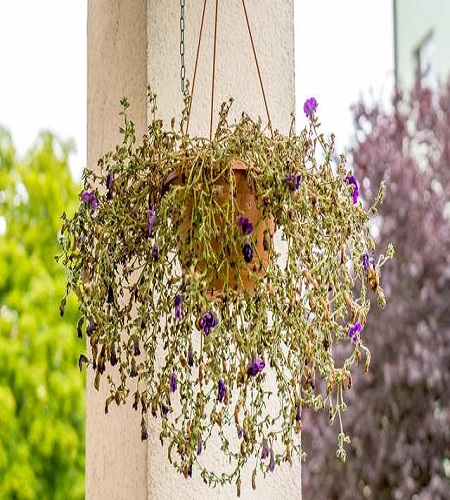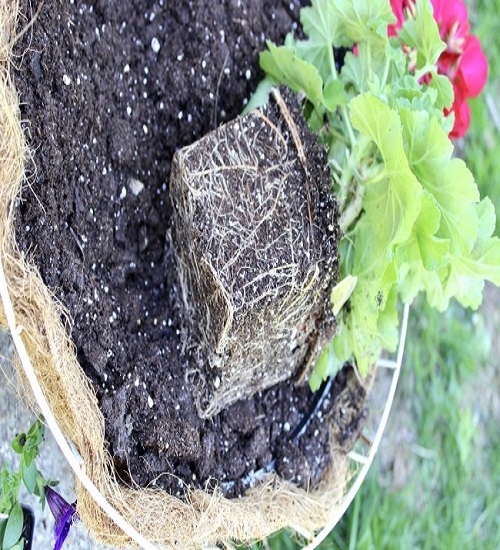Many flower baskets and potted plants begin to deteriorate as summer progresses. Flowers and leaves that were once vibrantly colored and ready to enliven a porch or patio now appear more as if they belong in the compost pile.
Don’t get rid of all of your plants just yet! It’s much simpler than you might expect to revive those unhappy plants. Even for individuals who haven’t experienced gardeners or don’t believe they have a “green thumb.”
Here are two easy ways to revitalize your plants and start them blooming big again, as well as an explanation of why most hanging baskets and containers fail.
Here are 2 methods to revive dying hanging baskets and containers.
Repotting
Replanting your hanging baskets and container plants into a larger container is the first and most usual approach for bringing them back to life.
Commercial hanging baskets are sold in ten and twelve-inch pots, which is a problem. Root growth can’t take place in these smaller baskets because there isn’t enough room for it. As a rule of thumb, baskets should be at least fourteen to sixteen inches tall at the beginning of the growing season.
You’ll need at least a quarter more room in your new basket or container to grow. More space is always preferable. Allowing the roots to spread out and bring in nutrients fast is essential for a healthy plant. Having enough space for your plant to last the rest of its season is more vital than anything.
Try these tips for rescuing and reviving your fading hanging baskets and potted plants.
Repotting Tips
You should begin by filling your container with high-quality potting soil before moving on to the next step of repotting. Before putting the root ball into the new basket, loosen the tightly bound roots. Gently separate the roots from the root ball by gently breaking apart the roots at the bottom of the root ball.
The bottom of the root-bound ball must be broken apart in order to succeed. This permits the plant to take in oxygen and adapt to the new soil. In doing so, it will be able to absorb the nutrients and water it needs to grow.
Adding worm castings to the potting soil mix is one of our favorite things to do. Incorporating the worm castings into your garden will help your plants recover much more quickly.
Finish by adding more potting soil to the pot and watering the plant thoroughly. Add some liquid fertilizer to the water as well. This is a critical part of the process! Liquid fertilizer will put the root-bound plants back into growth mode because they’ve been suffering from a lack of nutrient and water absorption for so long.

Replanting
You’ll have to dispose of the plant because it’s too big to fit in a basket or container you can locate. Don’t get rid of the plant again! As an alternative, consider replanting it in your landscape for an annual display of vibrant color.
Using this approach has been a great way to save money for us for years. Not only does it help save the plant, but it also brightens up any area of the yard that may need some extra color.
When placed in flowerbeds or garden spaces, large hanging baskets and container plants can enjoy a second life of their own. Soak some compost or worm castings into the soil while removing the plants from their containers, then plant them directly into the ground.
Provide plenty of water and liquid fertilizer to the plant, just as you would when transplanting it. This will help it get off to a good start in its new environment. You’ll be amazed at how rapidly the plant revives itself in the new area and soil.

Reasons why hanging baskets and containers fail
Diagnosis of the Issue
To begin, make sure that your plants aren’t suffering from a lack of care. Even if it’s due to a lack of nutrients, too much water, or a lack of water. Watering inconsistency or a lack of fertilizer are often to blame for plants’ poor performance.
The good news is that these kinds of problems are easy to fix with a bit of extra attention.
However, even well-maintained hanging baskets and containers tend to fade quickly in the early summer in many cases. No amount of water or fertilizer can assist these plants, either. It can definitely be annoying. This is especially true for gardeners who have spent countless hours watering, fertilizing, and otherwise tending to their crops.
Mid-Summer Failure
A well-maintained plant that suddenly begins to lose its shine in early or mid-summer can nearly always be traced to the plant becoming root-bound.
A plant’s roots are practically hard to absorb water or nutrients if they are tightly coiled together. When this occurs, the basket is completely submerged in water. The same is true for any fertilizers that have been used on the plant.
Leaving the plant in its container isn’t an option at this time, for obvious reasons. If the plant can’t absorb adequate nutrients, no amount of soaking or fertilizing will help. The plant will continue to deteriorate until it eventually dies.
As a result, what can a gardener do to help save their flora? Root-bound plants can be rejuvenated in two ways — both of which involve replanting. The most important thing is to get started as soon as possible, no matter whatever approach you choose from the ones listed below. The longer a plant is left to struggle, the more difficult it will be to revive it!


